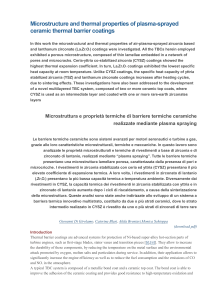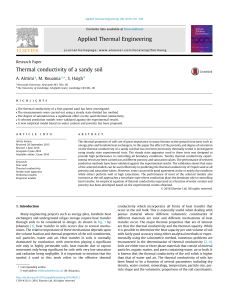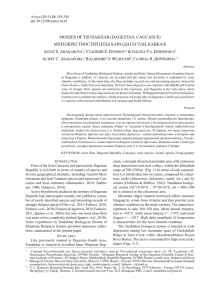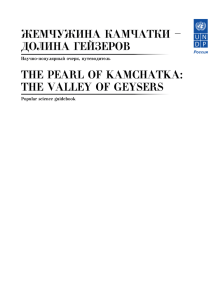anthocerotophyta – a new divisio of plants for the flora of
реклама
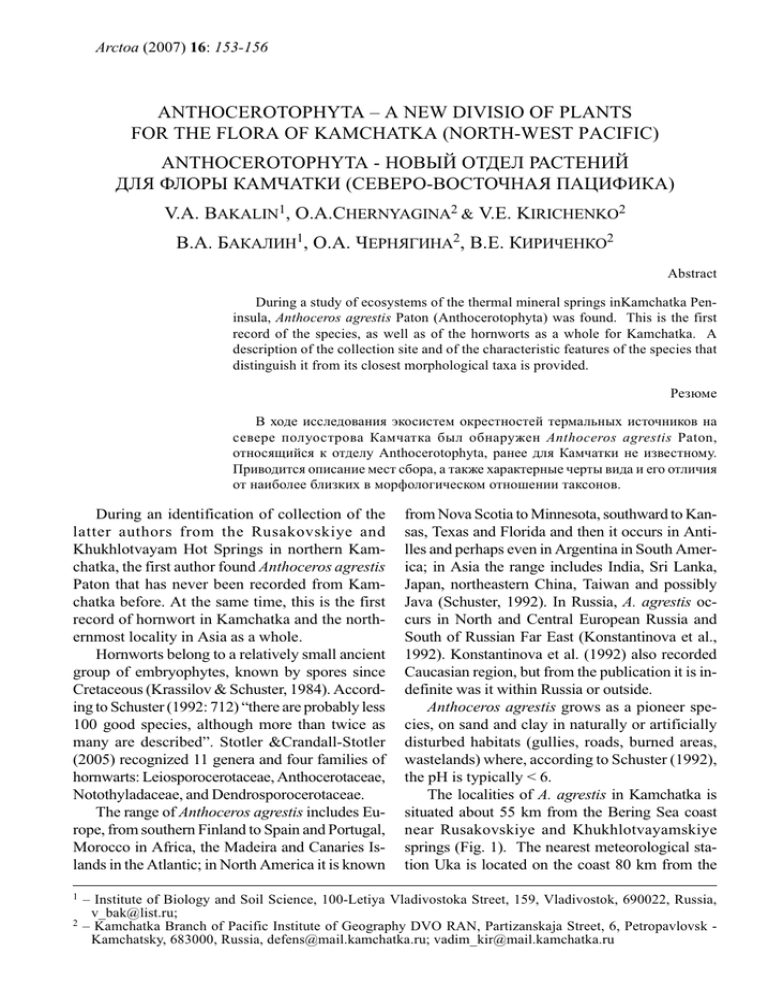
Arctoa (2007) 16: 153-156 ANTHOCEROTOPHYTA – A NEW DIVISIO OF PLANTS FOR THE FLORA OF KAMCHATKA (NORTH-WEST PACIFIC) ANTHOCEROTOPHYTA - НОВЫЙ ОТДЕЛ РАСТЕНИЙ ДЛЯ ФЛОРЫ КАМЧАТКИ (СЕВЕРО-ВОСТОЧНАЯ ПАЦИФИКА) V.A. BAKALIN1, O.A.CHERNYAGINA2 & V.E. KIRICHENKO2 В.А. БАКАЛИН1, О.А. ЧЕРНЯГИНА2, В.Е. КИРИЧЕНКО2 Abstract During a study of ecosystems of the thermal mineral springs inKamchatka Peninsula, Anthoceros agrestis Paton (Anthocerotophyta) was found. This is the first record of the species, as well as of the hornworts as a whole for Kamchatka. A description of the collection site and of the characteristic features of the species that distinguish it from its closest morphological taxa is provided. Резюме В ходе исследования экосистем окрестностей термальных источников на севере полуострова Камчатка был обнаружен Anthoceros agrestis Paton, относящийся к отделу Anthocerotophyta, ранее для Камчатки не известному. Приводится описание мест сбора, а также характерные черты вида и его отличия от наиболее близких в морфологическом отношении таксонов. During an identification of collection of the latter authors from the Rusakovskiye and Khukhlotvayam Hot Springs in northern Kamchatka, the first author found Anthoceros agrestis Paton that has never been recorded from Kamchatka before. At the same time, this is the first record of hornwort in Kamchatka and the northernmost locality in Asia as a whole. Hornworts belong to a relatively small ancient group of embryophytes, known by spores since Cretaceous (Krassilov & Schuster, 1984). According to Schuster (1992: 712) “there are probably less 100 good species, although more than twice as many are described”. Stotler &Crandall-Stotler (2005) recognized 11 genera and four families of hornwarts: Leiosporocerotaceae, Anthocerotaceae, Notothyladaceae, and Dendrosporocerotaceae. The range of Anthoceros agrestis includes Europe, from southern Finland to Spain and Portugal, Morocco in Africa, the Madeira and Canaries Islands in the Atlantic; in North America it is known 1 2 from Nova Scotia to Minnesota, southward to Kansas, Texas and Florida and then it occurs in Antilles and perhaps even in Argentina in South America; in Asia the range includes India, Sri Lanka, Japan, northeastern China, Taiwan and possibly Java (Schuster, 1992). In Russia, A. agrestis occurs in North and Central European Russia and South of Russian Far East (Konstantinova et al., 1992). Konstantinova et al. (1992) also recorded Caucasian region, but from the publication it is indefinite was it within Russia or outside. Anthoceros agrestis grows as a pioneer species, on sand and clay in naturally or artificially disturbed habitats (gullies, roads, burned areas, wastelands) where, according to Schuster (1992), the pH is typically < 6. The localities of A. agrestis in Kamchatka is situated about 55 km from the Bering Sea coast near Rusakovskiye and Khukhlotvayamskiye springs (Fig. 1). The nearest meteorological station Uka is located on the coast 80 km from the – Institute of Biology and Soil Science, 100-Letiya Vladivostoka Street, 159, Vladivostok, 690022, Russia, v_bak@list.ru; – Kamchatka Branch of Pacific Institute of Geography DVO RAN, Partizanskaja Street, 6, Petropavlovsk Kamchatsky, 683000, Russia, defens@mail.kamchatka.ru; vadim_kir@mail.kamchatka.ru 154 V.A. BAKALIN, O.A.CHERNYAGINA & V.E. KIRICHENKO Fig. 1. Localities of Antoceros agrestis in the Kamchatka Peninsula. Rusakovskiye springs. According to its data, the average annual air temperature is -2.7°С, the warmest month is August, with the average temperature 12.6°С; the coldest is January, -15.8°С (Spravochnik..., 1966). The snow cover is lasted for 222 days, from October 20 to May 6 (Spravochnik..., 1968). The thermal zone at the Rusakovskiye Hot Springs is free of snow during the winter, while average snow depth in adjacent areas reaching 2-2.5 meter. Studied specimens: North of Kamchatka Peninsula, Rusakova River Valley, 58°31’15"N 161°15’01"E, 270 m a.s.l., Rusakovskie hot springs, on strata of travertine1, 19.VIII.2007 leg. O.A. Chernyagina & V.E. Kirichenko; the same, 58°32’08’’N 161°18’14” E, 295 m alt., Khukhlotvayamskiye hot springs, on strata of travertine, 21.VIII.2007 leg. O.A. Chernyagina & V.E. Kirichenko. All specimens are kept in VLA. Near the Rusakovskiye springs Anthoceros agrestis is found on travertine with temperature on the surface is 22.8-24.6°С; at 2 cm deep - 23.325.3°С. The pH of the water samples was 5.8-6.1. Humidity is average and water puddles in the road ruts during the rainy season. The dominant plant 1 – natural precipitate of basically calcium carbonate deposited from the mineral springs colonies are Agrostis scabra (25-30%), Eleocharis uniglumis (Link) Schult (10%), Ranunculus repens L.(30%), Plantago asiatica L. (10%). Gnaphalium uliginosum L. (+) and Fimbristylis ochotensis (+) are noted. 25% of the area is covered in bryophytes (mosses – 16%, Conocephalum japonicum (Thunb.) Grolle and Anthoceros = ca. 8%). Anthoceros agrestis at the spring on the Khukhlotvayam River is found on a steep bank of a natural thermal pool (on travertine) above the hot water outlet (Fig. 2) with the soil temperature is 31.4°С at the surface and 37.1°С in the root zone. The pH is 5.2. A zone dominated with green algae delineates the thermal water vents; behind it is a community of Anthoceros agrestis+Fimbristylis ochotensis+Agrostis scabra +Artemisia opulenta Pamp.+Epilobium hornemannii Reichenb. Vascular plants make up less than 30% of the cover. The thermal area is bordered by a fern Oreopteris quelpaertensis (Christ.) Holub that separates the area from a dry, mixed grass meadow. These conditions are apparently similar to ones found in Iceland, where Phaeoceros carolinianus (Michx.) Prosk. (Damsholt, 2002; as P. laevis ssp. carolinianus (Michx.) Prosk.) grow along thermal springs. Anthocerotophyta – a new divisio of plants for Kamchatka Ñ 155 Ñ Ñ Ñ Fig. 2. A natural thermal pool at one of the Khukhlotvayam Hot Springs where Anthoceros agrestis Paton (arrows) was collected on steep banks. The present localities are ca. 2600 km to the north from nearest localities in Primorskiye Territory. The discovery raises a phytogeographic question: how is it that these hornworts are found on Kamchatka? Is it a result of a occasional introduction or are they a relict of earlier epochs when thermofilous species of this phylum were distributed much more broadly in the northeastern extremes of the Asian continent? The authors are inclined to latter. Earlier studies (Komarov, 1940; Lipshits, 1936; Chernyagina, 2000; Yakubov, Chernyagina, 2004 and others) show that the flora in the vicinity of thermal springs contains a small, but very specific group of species of relict distribution. They are known in Kamchatka only in these types of habitats. The similar group was recognized by the first author for hepatics; it includes, e.g. Plectocolea vulcanicola Schiffn. and Solenostoma fusiforme (Steph.) Schust. Anthoceros agrestis is further expanding the list of these thermophilous species. It seems likely to expect more findings of A. agrestis and other hornwotrs in thermal habitats where isolated northernmost localities of some species are known (cf. Barkalov, Yakubov, 2007). Secondly, the current find once again illustrates the need to study the flora of thermal habitats near hot and warm water mineral springs where volcanic activity is contemporary, and to include in those studies investigations of fumaroles, sulfur mud pools and other hydro-thermal surface outlets. ACKNOWLEDGMENTS The work of the first author was partially supported by grants provided by the RFBR (№ 0605-64137) Far Eastern Division of RAS (№№ 06-III-А-06-153, 06-III-В-06-190, 07-III-D-06044) and by the Russian Science Support Foundation. Expedition support to this distant and difficult to access portion of the Kamchatka Peninsula was provided by the Kamchatka League of Independent Experts, the Pacific Institute of Geography DVO RAN and Pacific Environment 156 V.A. BAKALIN, O.A.CHERNYAGINA & V.E. KIRICHENKO (USA) as part of a general program to study protected territories on Kamchatka that has been funded by the Rockefeller Brothers Fund (USA). The authors would also like to express their appreciation to Misha Jones for his translation into English of this paper. LITERATURE CITED [BARKALOV, V.Yu. & V.V. YAKUBOV] БАРКАЛОВ В.Ю., В.В. ЯКУБОВ 2007. Новый для России вид Psilotum nudum (Psilotaceae) с Курильских островов. – [Psilotum nudum (Psilotaceae), a new species to the flora of Russia from the Kuril Islands] Бот. журн. [Bot. Zhurn.] 92(12): 1946-1948. [CHERNYAGINA, O.A.] ЧЕРНЯГИНА О.А. 2000. Флора термальных местообитаний Камчатки. – [The Flora of Thermal Sites on Kamchatka] Труды Камчатского инта экологии и природопользования. Вып. 1., Петропавловск-Камчатский [Trudy Kamchatskogo inst. ekologii i prirodopol’zovaniya. Vyp. 1. Petropavlovsk-Kamchatsky]: 198-227. DAMSHOLT, K. 2002. Illustrated Flora of Nordic Liverworts and Hornworts. – Odense, Knud Graphic Consult. 1-840. [KOMAROV, V.L.] КОМАРОВ В.Л. 1940. Ботанический очерк Камчатки. – [Botanical Essay on Kamchatka]. Камчатский сборник.Т. 1. М.; Л.: Изд-во АН СССР [Kamchatsky sbornik. Vol. 1. Moscow-Leningrad, Izd-vo AN SSSR]: 5-52. KONSTANTINOVA, N.A., A.D. POTEMKIN & R.N. SCHLJAKOV. 1992. Checklist of the Hepaticae and Anthocerotae of the former USSR. – Arctoa 1: 87-127. KRASSILOV, V.A. & R.M. SCHUSTER. 1984. Paleozoic and Mesozoic fossils. – In: Schuster, R.M. (ed.) New manual of Bryology, Vol. II. Nichinan, Hattori Bot. Lab., 1172-1193. [LIPSHITS, S.YU.] ЛИПШИЦ С.Ю. 1936. К познанию флоры и растительности горячих источников Камчатки. – [Understanding of the Flora and Vegetation of the Hot Springs of Kamchatka] Бюлл. МОИП, Отд. биол. [Bull. Mosk. Obshch. Ispyt. Prirody. Otd. boil.] 45(2): 143-158. [NESHATAEVA, V.YU.] НЕШАТАЕВА В.Ю. 2006. Растительность полуострова Камчатка. [The Vegetation of the Kamchatka Peninsula]. Автореф. дисс. ... докт. биол. наук, Санкт-Петербург [Avtoref. diss. ... dokt. boil. nauk. Saint-Petersburg]: 1-42. [SCHLJAKOV, R.N.] ШЛЯКОВ Р.Н. 1976. Печеночные мхи Севера СССР T. 1. – [Hepaticae of the northern USSR North. Vol. 1.] Л., Наука [Leningrad, Nauka]: 91. SCHUSTER, R. M. 1992. The Hepaticae and Anthocerotae of North America. Vol. VI. Chicago, Field Museum of Natural History. 1-937. [SPRAVOCHNIK PO KLIMATU SSSR] СПРАВОЧНИК ПО КЛИМАТУ СССР. 1966. Выпуск 27. Камчатская область. Часть II. Температура воздуха и почвы. - [Vypusk 27. Kamchatskaya Oblast’. Chast’ II. Temperatura vozdukha I pochvy] Ленинград, Гидрометеорологическое издательство [Leningrad, Gidrometeorologicheskoe izdatel’stvo]: 184. [SPRAVOCHNIK PO KLIMATU SSSR] СПРАВОЧНИК ПО КЛИМАТУ СССР. 1968. Выпуск 27. Камчатская область. Часть IV. Влажность воздуха, атмосферные осадки, снежный покров. – [Vypusk 27. Kamchatskaya Oblast’. Chast’ IV. Vlazhnost’ vozdukha, atmosfernyye osadki, snezhnyy pokrov] Ленинград, Гидрометеорологическое издательство [Leningrad, Gidrometeorologicheskoe izdatel’stvo]: 211. STOTLER, R.E. & B. CRANDALL-STOTLER 2005. A revised classification of the Anthocerotophyta and a checklist of the Hornworts of North America, North of Mexico. – Bryologist 108(1): 16-26. [YAKUBOV, V.V. & O.A. CHERNYAGINA] ЯКУБОВ В.В., О.А. ЧЕРНЯГИНА 2004. Каталог флоры Камчатки (сосудистые растения). – [Catalogue of the flora of Kamchatka. Vascular Plants] Петропавловск-Камчатский, Камчатпресс [Petropavlovsk-Kamchatskiy, Kamchatpress], 165 pp.
